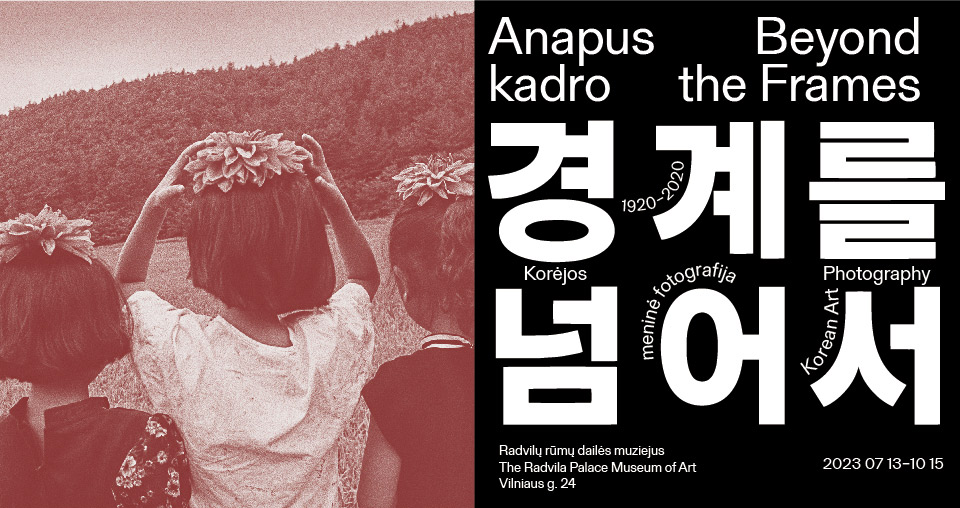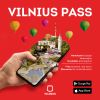Beyond the Frames: Korean Art Photography 1920s–2020s
13 July – 15 October 2023
 To commemorate the Year of Friendship between Lithuania and the Republic of Korea, for the first time in the Baltic States, an exhibition presenting Korean art photography Beyond the Frames: Korean Art Photography 1920s–2020s was inaugurated at the Radvila Palace Museum of Art of the Lithuanian National Museum of Art.
To commemorate the Year of Friendship between Lithuania and the Republic of Korea, for the first time in the Baltic States, an exhibition presenting Korean art photography Beyond the Frames: Korean Art Photography 1920s–2020s was inaugurated at the Radvila Palace Museum of Art of the Lithuanian National Museum of Art.
This exhibition was specifically created by the Museum Hanmi for the Lithuanian National Museum of Art in response to their exhibition titled Uncoverings: The Search for Identity in Lithuanian Photography, which took place in 2021 in Seoul as part of a bilateral exhibition exchange. The largest exhibition of Lithuanian photography in Asia to date was organized in cooperation with the Ministry of Foreign Affairs and the Ministry of Culture of the Republic of Lithuania and the Lithuanian Culture Institute.
“The ongoing cooperation between museums in Lithuania and South Korea continues to create opportunities for both societies to deepen their understanding of one another. The highly successful Lithuanian photography exhibition in Seoul and the current Korean photography exhibition in Vilnius showcase distinct cultures and outstanding works of art, invite us to reflect on the parallels of historical experiences from a contemporary perspective, and allow Lithuanians and Koreans to see each other’s faces,” says Dr Arūnas Gelūnas, Director General of the National Museum of Art.
Curator Sunyoung Kim has selected over 100 works from the Museum Hanmi collection, representing a comprehensive panorama of South Korean art photography spanning the last century. The exhibition not only offers a chronological overview of the evolution of photography but also delves into the innovative creative strategies employed by photographers in response to historical, social, and political circumstances.
Documenting Everyday Life through the Eyes of Artists
The history of modern South Korea is marked by occupation, evacuation, war and the struggle for independence. In the face of hardship, photographers have been forced to face up to a harsh reality. Therefore, in the work of the 14 photographers featured in the exhibition, the search for new themes and techniques and for a distinctive artistic language inevitably overlaps with the complex experiences of the country and each of them.
Three parts of the Beyond the Frames exhibition chronologically respond to the three main phases of South Korean photography – the beginning of the art photography movement in the 1920s, the modernist turn in the 1960s–1980s, and the movement towards contemporary art. At the beginning, visitors are introduced to the origins of South Korean photography and the efforts to establish it as a pure art form. Artists of this period were influenced by Pictorialism and the modernist New Vision movement in Europe. These two styles conflicted in the West, but reached Korea at a similar time and existed side by side.
JUNG Haechang (1907–1968), who successfully combined both styles, held a solo exhibition of his work in 1929, thus being the first in South Korea to establish photography as an independent form of artistic expression. This exhibition served as an inspiration for other photographers to move in an artistic direction. JUNG’s self-portraits, still lifes, portraits and landscapes will be on show at the Radvila Palace Museum of Art.
Artists representing Korean modernist photography, which was established in the 1960s, are presented in the second part of the exhibition. Realism became the mainstream of photography, press photography began to dominate, and groups of artists working on documentary images began to form. Not surprisingly, many of the artists featured in the exhibition started out as photojournalists. Traditional life displaced by modernisation, alienation, a rapidly changing society – all of these processes were captured by their cameras. However, even in the realistic milieu, there were artists who delved into experimentation and the avant-garde, and who did not shy away from humor, for example HWANG Kyu-Tae (b. 1938), who is featured in this exhibition.
Photography’s Steps Towards Contemporary Art
The third part of the exhibition covers the past three decades, exploring the breakthrough of photography within the realm of contemporary art. The first generation of Korean photographers who studied abroad and its leader Bohnchang KOO (b. 1953) were the driving force. As he returned from studies in Germany, KOO scratched the surface of photographic film, cut, then glued or sewed together pieces of photographs, searching for new means of expression.
The artist Chan-Hyo BAE (b. 1975), who will be attending the opening of the exhibition, left his previous life behind in 2004 and moved to London, where he still lives and works today. Looking for ways to overcome the cultural differences and identity confusion he experienced as an Asian studying in the UK, he immersed himself in an unfamiliar British culture and tested the boundaries of photographic portraiture. These are just a few of the representatives of South Korean photography, which remains relatively unfamiliar in the Lithuanian context. Despite the variations in time periods and political circumstances, all 14 featured artists were attentive to their surroundings, responded vividly to change, and at times even instigated it through their unique artistic language.
Curator Sunyoung Kim, who learned about the history of our country in the Lithuanian photography exhibition in Seoul, sees some parallels: “The exhibition focuses on historical upheavals, social unrest and photographers’ reactions to these processes. We have chosen this approach because we believe that the people of both countries have a unique, but at the same time unifying, sensitivity and understanding of turbulent history. The ‘three frames’ presented in Beyond the Frames, which forced the photographers to make new experiments, are symbols of historical periods. The course of photography is inseparable from history.”
Organizers: Museum Hanmi, Radvila Palace Museum of Art of the Lithuanian National Museum of Art
Artists: JUNG Haechang, HYUN Ilyoung, LIMB Eungsik, HWANG Kyu-Tae, JOO Myung Duck, KANG Woongu, Bohnchang KOO, LEE Sanghyun, Byung-Hun MIN, LEE Gap Chul, Hein-kuhn OH, Kyungwoo CHUN, KOH Myung Keun, Chan-Hyo BAE
Curator Sunyoung Kim
Architect Ūla Žebrauskaitė-Malinauskė
Graphic Designer Laura Grigaliūnaitė
Coordinator Ugnė Marija Makauskaitė
Head of Communication Goda Aksamitauskaitė
Architect-Coordinator Aleksandras Kavaliauskas
Coordinator’s Assistant Lina Jonkuvienė
Light designer Milvydas Kezys
Collection management: Eunjung Choi, Hee Jung Kim
Restorers: Rytė Šimaitė, Jurgita Blažytė-Denapienė
We are grateful to the Ambassador of the Republic of Lithuania in the Republic of Korea Ričardas Šlepavičius
Partner Korean Culture Center
Media Sponsors: JCDecaux, bepavadinimo.eu
Radvila Palace Museum of Art,
24 Vilniaus st, LT-01402, Vilnius, Lithuania
+370 5 250 5824













